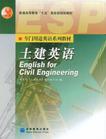土建英语
出版时间:2000.7.1 出版社:高等教育出版社 作者:教育部土建英语教材编写组 编 页数:235
Tag标签:无
前言
专门用途英语系列教材是教育部规划的高等学校专业英语阶段的英语教材。本系列教材从培养高级应用型人才的总体目标出发,结合学生毕业后的工作实际,力求向学生提供其未来工作岗位所需要的专业英语知识和技能,培养学生使用涉外业务英语的能力。 本系列教材每册书都由10个单元组成,每单元至少包括阅读与翻译、模拟套写和听力与会话三部分。 本系列教材主要供高等院校(包括高等专科院校和高等职业院校)专业英语教学使用,也可供电大、各类成人院校及广大专业人员学习专业英语,提高涉外业务交际能力使用。 《土建英语》系本系列教材中的一种,旨在提高土木建筑类的学生和从业人员在建筑领域的涉外业务英语交际能力,其中包括专业阅读、翻译、写作和口头交际的能力. 《土建英语》共10个单元,每单元分为以下四个部分: 第一部分“建筑英语词语图示”(Illustrated Words and Expressions),通过标注涉外建筑工程图纸和施工过程中的常用词汇和表达法,帮助学生形象地学习建筑英语词语。图示的内容涉及建筑设计、木结构、砖石结构、钢结构、建筑机械、砌筑工具等诸多方面。 第二部分“阅读与翻译”(Reading and translating),旨在培养学生阅读和翻译土木建筑专业英语的能力。本部分收入了两类文章:第一类为专业技术性文章,用来培养学生阅读和翻译土木建筑专业技术文献的能力,内容涉及设计过程、基础、墙体、楼面、屋顶结构、预制结构、隧道、道路、桥梁、污水处理等;第二类为土木建筑专业领域的实用性文章,如中标函、建筑规范、工程造价等,还包括反映建筑领域的新设计、新技术和新产品的文章,如世纪大厦、德国重新考虑区域供暖、香港上海汇丰银行、高效节能废水处理、计算机在建筑中的应用等。 第三部分“模拟套写”(Simulated WritinK),旨在培养学生参照范例用英语拟写和翻译建筑领域的涉外信函、传真、电子邮件以及合同、产品广告、产品介绍、产品使用说明和招标通告等应用文的能力. 第四部分“听力与会话”(Listening and Speaking),旨在培养学生进行土木建筑专业涉外口语交际的能力。内容涉及安排会议、施工前期准备、甲方与项目经理会谈、现场勘察、招投标、施工组织与管理、施工进度、工程质量评估、质量控制等。 本教材构思独特、实用性强,尤其突出了土木建筑专业的涉外业务实际需要;选材新颖、点面结合、内容丰富、语言规范;练习的设计兼具实用性和针对性。每单元各个部分均注有生词和短语,并配有适量的练习,书后附有练习答案和参考译文,便于学习者学中用,用中学。
内容概要
专门用途英语系列教材是教育部规划的高等学校(包括高等专科院校和高等职业院校)专业英语阶段的英语教材,也可供电大、各类成人院校及广大专业人员学习专业英语、提高涉外业务交际能力使用。 《土建英语》是该系列教材之一。《土建英语》从专业人员实际工作的需要出发进行设计和编写。选材新颖、点面结合、内容丰富、语言规范:练习兼具实用性和针对性。 全书由10个单元组成,每单元包括专业文献阅读与翻译,涉外业务应用文模拟套写和专业会话三部分。书后附有练习参考答案和课文参考译文。
书籍目录
Unit 1 DesignProcessPart Ⅰ Illustrated Words and Expressions: Architecture DesignPart Ⅱ Reading and TranslatingPassage A: Introduction to DesignProcessPassage B: The London Millennium TowerPart Ⅲ Simulated Writing: Advertisement (1)Part Ⅳ Listening and Speaking: Arranging a MeetingUnit 2 FoundationPart Ⅰ Illustrated Words and Expressions: Stairs and StepsPart Ⅱ Reading andTranslating.Passage A: Foundation ConstructionPassage B: Rethinking District Heating in GermanyPart Ⅲ Simulated Writing: Advertisement (2)Part Ⅳ Listening anti Speaking: Discussion of aProject at a PreliminaryPhaseUnit 3 WallingPart Ⅰ Illustrated Words and Expressionsi Window DetailPart Ⅱ Reading and TranslatingPassage A: Solid Walling andPartition WallingPassage B: Hong Kong Shanghai BankPart Ⅲ Simulated Writing: Advertisement (3)Part Ⅳ Listening and Speaking: Talks Between the Owner and the Program ManagerUnit 4 FloorsPart Ⅰ Illustrated Words anti Expressions: Sheet Metal WorkPart Ⅱ Reading anti TranslatingPassage A: Solid Floors and Timber FloorsPassage B: Nullifire System SPart Ⅲ Simulated Writing:Product InstructionPart Ⅳ Listening and Speaking: Site InspectionUnit 5 RoofsPart Ⅰ Illustrated Words and Expressions: Roof StructurePart Ⅱ Reading and TranslatingPassage A: Roof ConstructionPassage B: Computer Applications in ConstructionPart Ⅲ Simulated Writing:Performance Security (Bank Guarantee)Part Ⅳ Listening and Speaking: BiddingUnit 6 PrefabricationPart Ⅰ Illustrated Words and Expressions: Methods of JointingPart Ⅱ Reading and TranslatingPassage A:Prefabricated ConstructionPassage B: A High-efficiency and Energy-saving Wastewater Treatment TechniquePart Ⅲ Simulated Writing: Subcontract AgreementPart Ⅲ Listening and Speaking: Field ManagementUnit 7 TunnelsPart Ⅰ Illustrated Words and Expressions: Brick StructuresPart Ⅱ Reading and TranslatingPassage A: Traffic Tunnel ConstructionPassage B: DrawingsPart Ⅲ Simulated Writing: E-mailPart Ⅳ Listening and Speaking: Claims and Back-chargesUnit 8 RoadsPart Ⅰ Illustrated Words and Expressions: Building MachineryPart Ⅱ Reading and TranslatingPassage A: Modem RoadPassage B: Cost Variance inProjectPart Ⅲ Simulated Writing: Fax MessagePart Ⅳ Listening and Speaking: Construction ScheduleUnit 9 RridgesPart Ⅰ Illustrated Words and Expressions: Steel Structures Reading and TranslatingPart ⅡPassage A: Fleher Cable-stayed Suspension Bridge in Get~x~any Passage B: Role of Specification in ConstructionPart Ⅲ Simulated Writing: Contract AgreementPart Ⅳ Listening and Speaking: Talks on Value-engineeringUnit 10 Sewage DisposalPart Ⅰ Illustrated words and Expressions: Bricklayers Tools Reading and TranslatingPart Ⅱ Passage A: Efficient Sewage DisposalPassage B: Letter of AcceptancePart Ⅲ Simulated Writing: Invitation for BidsPart Ⅳ Listening and Speaking: Quality Control
章节摘录
Most good landscape architects employ a series of analytical and creative thinking stepsreferred to as the "Design Process" to arrive at a built site design that correctly meets all thenecessary requirements in the most efficient and aesthetically pleasing manner possible. Thedesign process has a number of uses including the following: 1. It provides a logical and organized framework for creating a design solution. 2. It helps to insure the solution that does evolve will be appropriately suited to the givencircumstances of the design(the site, the client's needs, budget, etc.). 3. It aids in determining the best use of the land for the client by studying alternative solutions. 4. It serves as a basis of explaining and defending the design solution to the client. The design process, also sometimes termed as "problem solving process", includes a seriesof steps which usually (though not necessarily) follow a sequential order. In general terms, thesesame steps are also used by architects, industrial designers, engineers, and scientists to solveproblem. For site designers, the design process typically include these steps: 1. Client Contract ……
图书封面
图书标签Tags
无
评论、评分、阅读与下载
